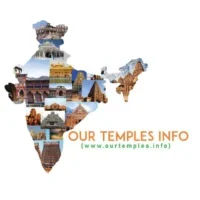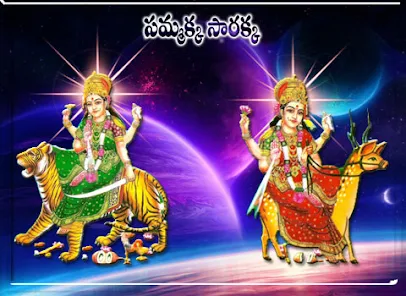Sammakka Saralamma Jathara or Medaram Jathara is a tribal festival of honouring the goddesses celebrated in the state of Telangana, India. The Jathara begins at Medaram in Tadvai Mandal in Mulugu district. It commemorates the fight of a mother and daughter, Sammakka and Saralamma, with the reigning rulers against an unjust law. It is believed that after Kumbha Mela, the Medaram Jathara attracts the largest number of devotees in the country. An estimated 10 million people gathered in 2012. It is celebrated in Medaram during the time the goddesses of the tribals is believed to visit them. Medaram is a remote place in the Eturnagaram Wildlife Sanctuary, a part of Dandakaranya, the largest surviving forest belt in the Mulugu.
There are many legends about the miraculous powers of sammakka. According to a tribal story, about 6-7 centuries ago, that is in the 13th century, some tribal leaders who went for a hunting found a new born girl (Sammakka) emitting enormous light playing amidst tigers. She was taken to their habitation . The head of the tribe adopted her and brought up as a chief tain (She later became the saviour of the tribals of the region) she was married to Pagididda Raju a feudatory tribal chief of Kakatiyas(who ruled the country of Andhra from Warangal City between 1000 AD and 1380 AD).She was blessed with 2 daughters and one son namely Sarakka, Nagulamma and Jampanna respectively.
Ritual
Sammakka Saralamma Jathara is the time for the largest tribal religious congregation in the world, held every two years (biennually), with approximately ten million people converging on the place, over a period of four days, which is 90km from Warangal city. The Sammakka Saralamma Jathara is a State Festival of Govt. of Telangana. Many tribal Devotees from different states of India (M.P, Chhattisgarh, Orissa, Maharashtra, Karnataka and parts of Jharkhand)reach to the festive place to celebrate the Jathara. People offer bangaram/gold (jaggery) of a quantity equal to their weight to the goddesses and take holy bath in Jampanna Vagu (stream). It is a festival with no vedic or brahmanic influence.
Until 1998, the only way to reach Medaram was by a bullock cart. In 1998 the state government declared the 1000-yr old festival as official and laid down a motorable road. In 2008, nearly 8 million people were estimated to have attended the festival. And in recent times the gatherings in the Jathara are roughly near 10 million. This fair is said to be the largest repeating congregation of tribal communities in the world. The traffic jam during the festival sometimes goes as far as 60 km on the Warangal highway. In 2012, approximately 1 crore people would attend the world’s largest tribal festival.
Jampanna Vagu
Jampanna vagu is a tributary to River Godavari. According to the history, Jampanna is the tribal warrior and the son of Tribal Goddess Sammakka. The Jampanna vagu took his name as he died in a battle fighting against Kakatiyan Army in that stream .The Jampanna vagu is still red in colour marked with the blood of Jampanna (Scientifically the red colour of the water is attributed to the soil composition). Tribal’s believe that taking a holy dip in the red water of Jampanna Vagu reminds them the sacrifice of their gods who save them and also induces courage into their souls. There is a bridge constructed on top of Jampanna Vagu, known as Jampanna Vagu bridge.
The dates of the Medaram Sammakka-Saralamma Mahajatara for 2024 have been finalized. The Mahajatara will be celebrated for four days in the month of February. The temple priests announced the dates of the Medaram Mahajatara to be held in 2024. The Mahajatara will be held from February 21 to 24.
On Day 1, February 21, Sarakka’s idol is carried from Kannepalli to Medaram. Pagididda Raju’s idol is carried from Poonugondla to Medaram.
On Day 2, February 22, Sammakka’s idol and the Kumkum casket are carried to Medaram (usually by midnight) after long pujas by the Koya tribes on Chilakalagutta (the hill where the Kumkum casket is kept). Govinda Raju’s idol is carried from Kondai to Medaram.
On Day 3, February 23, Sammakka and Saralamma along with their consorts Pagididda Raju and Govinda Raju respectively, are worshipped.
On Day 4, February 24, The Jatara ends with the “Tallula Vanapravesham” (entry into the forest). The Kumkum casket is carried back to Chilakalagutta and kept there until the next Jatara.

